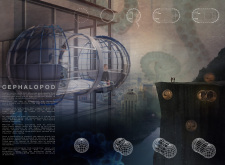5 key facts about this project
CEPHALOPOD is a design that combines technology with the idea of mobility in living spaces. Located in an unspecified contemporary environment, it functions as a micro home that adapts to different surroundings. The design seeks to address the limitations of traditional domesticity, responding instead to a world where people are increasingly mobile.
Mobility and Structure
The design features two primary components: an external sphere with a truss frame and a smaller internal sphere. The outer sphere is equipped with millions of suckers that allow it to roll smoothly across various surfaces. This unique method of movement is based on how a rolling ball operates, granting the ability to navigate different landscapes effectively.
Stability and Adaptability
Inside, the internal sphere uses magnetic levitation technology to provide a level living surface at all times. This is important for maintaining comfort and stability within the mobile home, even as it moves. This design element helps resolve some challenges related to mobile living by ensuring that occupants can reside in a safe and stable environment regardless of external conditions.
Transformative Design
When it arrives at a destination, the two spheres can separate and extend outward to create a larger area for living. This ability allows the internal space to function as various rooms, such as a dining area or sleeping area, all within one compact design. The space also includes a kitchen and bathroom, addressing essential needs and reinforcing the suitability of this design for everyday life.
Technological Integration
The design draws upon ideas from various industries, including automotive and aerospace. This cross-disciplinary approach helps enhance both the strength and performance of the structure. Additionally, inspiration from cephalopod mollusks adds a layer of adaptability, reflecting how these creatures efficiently navigate their environments.
Operable furniture located within the internal sphere allows for better use of the space, enabling occupants to configure their living area based on their needs. This design detail emphasizes the balance between functionality and innovation, showcasing how modern living can be both practical and flexible.



















































